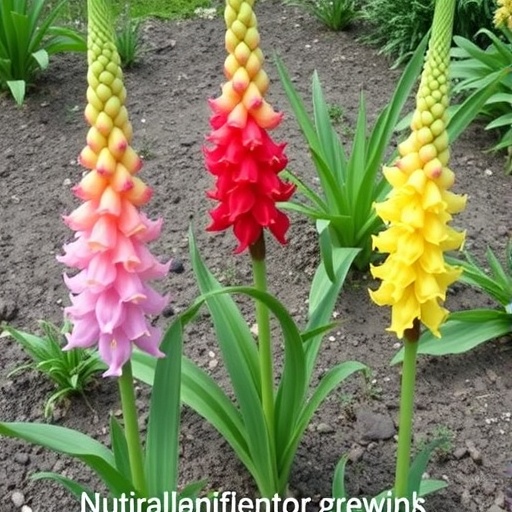In the world of horticulture, researchers continually seek effective methods to enhance plant growth and harvest quality. A notable study recently published in a prestigious journal provides insights into the effect of nutrient sources on the growth and physiological attributes of Gladiolus hybridus, commonly known for its striking floral displays. This research is particularly pertinent for those working in floriculture and sustainable agriculture, as it delves into the key parameters affecting the blooming and overall vitality of the renowned ‘Snow Princess’ cultivar.
This pioneering research, conducted by an enthusiastic team of scientists, investigated how different nutrient sources impact the growth dynamics, flowering processes, and microbial enzymatic activities in the post-harvest soil of Gladiolus hybridus. The study was initiated against the backdrop of an increasing demand for ornamental plants and the need for improved production practices that are environmentally sustainable. Understanding the nutrient dynamics in soil can lead to advancements in cultivation techniques, yielding healthier plants and more vibrant flowers.
One of the most striking findings of this research was the critical role that nutrient sources play in plant growth. The team evaluated a range of nutrient formulations, each varying in composition and source, to ascertain how they influence various growth parameters. This involved a detailed analysis not only of plant height and leaf area but also of stem thickness and flower count, providing a holistic view of plant development. The findings indicate that the right nutrient combination can distinctly elevate the growth trajectory of the plant, leading to more robust structures and improved aesthetic qualities.
Moreover, the study examined the timing of nutrient application, which is vital in ensuring that plants receive necessary nutrients during key developmental stages. This aspect is essential since nutrient uptake varies at different growth phases. The researchers discovered that nutrient application aligned with the flowering period resulted in an impressive increase in flower quantity and quality. This result is particularly significant for commercial growers who aim to maximize the floral yield of their crops.
In addition to growth parameters, the researchers closely monitored flowering characteristics. The results revealed a remarkable correlation between nutrient sources and flowering time. Specific nutrient combinations not only hastened the flowering process but also improved flower retention. Understanding these dynamics aids growers in planning their planting schedules better, ultimately aligning flower production with market demand.
Microbial activity in the soil, often overlooked in horticultural studies, was also a focal point of the research. The investigation into microbial enzymatic activities yielded fascinating insights into soil health. Microorganisms play a pivotal role in nutrient cycling, and their enzymatic activities serve as indicators of soil vitality. The findings from this study emphasize that nutrient-rich soil leads to enhanced microbial activities, creating a more fertile environment that supports plant health and growth.
Through sophisticated methods, the researchers measured various enzymatic activities, which included those responsible for the decomposition of organic matter and nutrient release. The correlation between these microbial processes and plant growth underscores the importance of maintaining good soil health to achieve optimal growth outcomes. A thriving microbial community not only enriches the soil profile but also enhances nutrient availability for plants.
The implications of this research extend beyond Gladiolus cultivation. The principles discovered regarding nutrient sources and soil microbial interactions can be applied to various horticultural practices. For instance, similar methodologies could be utilized to improve the growth of other ornamental plants or even in food crop production, leading to broader agricultural advancements.
With increasing attention on environmentally conscious farming methods, this research underscores the necessity of sustainable nutrient management strategies. By utilizing organic and integrated nutrient sources, growers can boost their crop yields while minimizing the use of synthetic fertilizers. This is a significant step towards environmentally responsible agriculture, which is essential for preserving ecosystems while meeting food and aesthetic demands.
Commercial growers, landscapers, and horticulturists are now presented with actionable insights that can improve their practices. The detailed exploration of how different nutrient sources operate will empower them to make informed decisions regarding fertilization strategies. Tailoring nutrient applications not only optimizes growth but also contributes to cost-effective farming owing to increased production rates.
Finally, while the study focused specifically on Gladiolus hybridus, its ramifications resonate throughout the horticultural industry. As growers become more attuned to the science of plant nutrition, we may witness a paradigm shift in how floral crops are cultivated. Future research may continue down this path, exploring other cultivars and expanding our understanding of sustainable cultivation practices that embrace both productivity and ecological health.
Thus, this comprehensive exploration into the effectiveness of various nutrient sources stands to impact the horticultural community significantly. By demonstrating the direct correlation between cultivation practices and plant health, the insights gained from this research will encourage other scientists and practitioners to delve deeper into the variables that contribute to successful floriculture.
In conclusion, the findings from this study underscore the critical intersection of plant biology, soil health, and sustainable farming. As the demand for beautiful, high-quality flowers continues to rise, such research sets a foundation for future advancements in the cultivation of not just Gladiolus but a wide spectrum of ornamental plants.
Subject of Research: The effect of sources of nutrients on growth, flowering, and microbial enzymatic activities in the post-harvested soil of Gladiolus hybridus.
Article Title: Effect of sources of nutrients on growth, flowering, and microbial enzymatic activities in post-harvested soil of gladiolus (Gladiolus hybridus Hort.) cv. snow princess.
Article References:
Kumar, M., Chaudhary, V., Chaudhary, V. et al. Effect of sources of nutrients on growth, flowering, and microbial enzymatic activities in post-harvested soil of gladiolus (Gladiolus hybridus Hort.) cv. snow princess.
Discov. Plants 2, 310 (2025). https://doi.org/10.1007/s44372-025-00393-z
Image Credits: AI Generated
DOI:
Keywords: Plant nutrition, Gladiolus hybridus, microbial activity, sustainable agriculture, ornamental cultivation.




